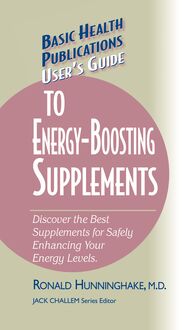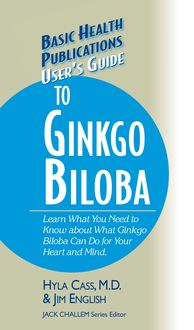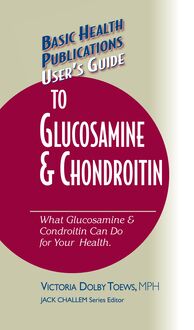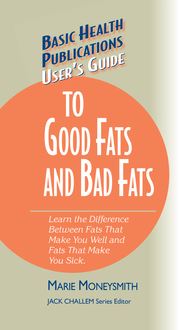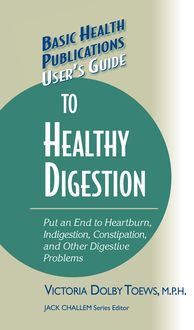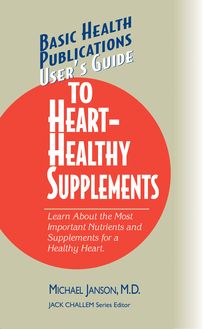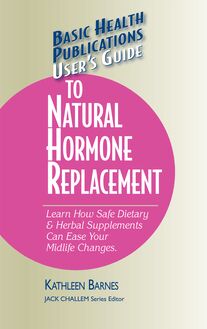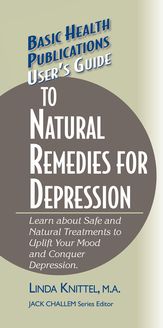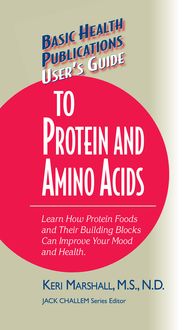-
 Univers
Univers
-
 Ebooks
Ebooks
-
 Livres audio
Livres audio
-
 Presse
Presse
-
 Podcasts
Podcasts
-
 BD
BD
-
 Documents
Documents
-
- Cours
- Révisions
- Ressources pédagogiques
- Sciences de l’éducation
- Manuels scolaires
- Langues
- Travaux de classe
- Annales de BEP
- Etudes supérieures
- Maternelle et primaire
- Fiches de lecture
- Orientation scolaire
- Méthodologie
- Corrigés de devoir
- Annales d’examens et concours
- Annales du bac
- Annales du brevet
- Rapports de stage
La lecture à portée de main
Vous pourrez modifier la taille du texte de cet ouvrage
Découvre YouScribe en t'inscrivant gratuitement
Je m'inscrisUser's Guide to Natural Hormone Replacement , livre ebook
Découvre YouScribe en t'inscrivant gratuitement
Je m'inscrisEn savoir plus
Vous pourrez modifier la taille du texte de cet ouvrage
En savoir plus

Description
Sujets
Informations
| Publié par | Turner Publishing Company |
| Date de parution | 01 janvier 2006 |
| Nombre de lectures | 0 |
| EAN13 | 9781591206910 |
| Langue | English |
| Poids de l'ouvrage | 1 Mo |
Informations légales : prix de location à la page 0,0298€. Cette information est donnée uniquement à titre indicatif conformément à la législation en vigueur.
Extrait
The information contained in this book is based upon the research and personal and professional experiences of the author. It is not intended as a substitute for consulting with your physician or other healthcare provider. Any attempt to diagnose and treat an illness should be done under the direction of a healthcare professional.
The publisher does not advocate the use of any particular healthcare protocol but believes the information in this book should be available to the public. The publisher and author are not responsible for any adverse effects or consequences resulting from the use of the suggestions, preparations, or procedures discussed in this book. Should the reader have any questions concerning the appropriateness of any procedures or preparations mentioned, the author and the publisher strongly suggest consulting a professional healthcare advisor.
Series Editor: Jack Challem
Editor: Jane Morrill
Typesetter: Theresa Wiscovitch
Series Cover Designer: Mike Stromberg
Basic Health Publications User’s Guides are
published by Basic Health Publications, Inc.
28812 Top of the World Drive
Laguna Beach, CA 92651
949-715-7327
Copyright © 2006 by Kathleen Barnes
ISBN 13: 978-1-59120-691-0
ISBN: 1-59120-171-3
All rights reserved. No part of this publication may be reproduced, stored in a retrieval system, or transmitted, in any form or by any means, electronic, mechanical, photocopying, recording, or otherwise, without the prior written consent of the copyright owner.
Printed in the United States of America
10 9 8 7 6 5 4 3 2 1
C ONTENTS
Introduction
1. Perimenopause: New Beginnings
2. Your Changing Body
3. Finding the Right Doctor
4. Conventional Medicine’s Approach
5. Dealing with Menopausal Symptoms
6. Postmenopause: A Woman’s Needs
7. A Suitable Diet
8. The Best Exercise
9. Natural Herbs and Supplements
10. Stress Management, Meditation, and More
11. Bioidentical Hormone Replacement
Conclusion
Selected References
Other Books and Resources
I NTRODUCTION
O ur mothers and grandmothers whispered the words, “The Change.” We could hear the capital letters. We could hear the dread in their voices. If we watched carefully, we could see the older women exchange knowing nods of sympathy and then quickly change the subject.
Until the past decade or so, menopause and perimenopause were subjects of deep dark mystery. Medical science knew little about “The Change” that will eventually affect all women. The women of our mothers’ or grandmothers’ era had only the word-of-mouth exchanged over countless cups of tea and chats over the back fence. Only with a generation of Baby Boomers who demand answers and results has menopause become a topic of popular discussion and increasing medical research.
In the mid-1900s, when scientists and the pharmaceutical industry discovered that the urine of all mammals contained estrogen, a new industry was born. Placid pregnant mares were an easy source, and from their urine, hormone replacement drugs were made that remain conventional medicine’s treatment of choice for the symptoms of menopause.
Millions of women found relief from the hot flashes, mood swings, insomnia, night sweats, and short-term memory loss that often go hand-in-hand with the approach of menopause. Doctors told women they’d need to take these drugs for a lifetime—and assured them that the estrogen in synthetic hormone replacement would protect them against heart attacks, strokes, cancer, and Alzheimer’s disease.
We now know that this information is 180 degrees from the truth. In 2002, more than fifty years after equine-based hormone replacement therapy (HRT) went on the market, the Women’s Health Initiative, a large clinical study, brought the truth out once and for all. Equine-based HRT combined with synthetic progesterone offered no protection at all from those dread diseases. In fact, it actually increased the risk of heart attack by 27 percent and the risk of stroke by 38 percent. Women taking these drugs more than doubled their risk of blood clots.
If that wasn’t bad enough, later results of the study released in 2004 showed that the drugs also increased the risk of dementia and other neurological illnesses such as Alzheimer’s disease by a stunning 105 percent. And the drugs increased the risk of type 2 diabetes by 21 percent.
The medical profession was in a dither. Many women stopped taking their equine-based hormone replacement drugs cold-turkey, throwing their bodies into hormone swings that, by comparison, made the early phases of menopausal hot flashes seem like a Sunday School picnic. Sadly, the vast majority of doctors are still basically clueless about natural ways to address menopause. Even more sadly, their patients haven’t had the benefit of gentle and natural ways to approach this natural life transition.
Today, 40 million American women are somewhere in the process of menopause. By 2015, 60 million of us will be in menopause and perimenopause and half of all American women will be at some point in “The Change.” The sheer weight of those numbers has forced medical science and society in general to re-examine a subject that was once a scientific backwater.
This new knowledge and the new openness about this women’s mystery are welcome. However, we are discovering that our foremothers had many of the answers to the issues of menopause in their herb cabinets. This book is intended to help you understand what’s happening in your body as hormone levels begin to fluctuate, and to give you a menu of natural ways to relieve your symptoms and improve your long-term health and longevity. If you’ve been taking equine-based HRT, you’ll learn how to safely withdraw from the drugs and replace them with harmless, healthy natural alternatives.
So, curl up with a steaming cup of herbal tea, and read away. Your body will thank you!
CHAPTER 1
P ERIMENOPAUSE: N EW B EGINNINGS
P erimenopause is the phase between the beginning of hormonal changes and full menopause, which is medically defined as the absence of menstrual periods for twelve months. Technically, perimenopause begins when your ovulation becomes irregular because your ovaries have released just about all the viable eggs with which you were born. It signals an alteration in your body’s natural production of two essential hormones: estrogen and progesterone.
Throughout your life, your pituitary gland sends signals to your ovaries to produce more estrogen. Sometimes, your ovaries respond to the message, and sometimes, as you get older, they don’t. As a result, in perimenopause your estrogen levels fluctuate by the month, by the day, and even by the hour. Fluctuating estrogen and falling progesterone levels can cause a variety of annoying symptoms ranging from the dreaded hot flashes, to butt-of-male-jokes irritability and mood swings, to debilitating hormonal headaches, depression, and joint pain.
Perimenopause The period before menopause, characterized by hormonal fluctuations.
The list of symptoms is long. Each woman’s perimenopause is unique. Some women sail through it with barely noticeable symptoms, while others suffer in the extreme. Most women fall somewhere in the middle, with one or two symptoms becoming particularly bothersome. The most common perimenopausal symptoms are: Depression Erratic menstrual cycles Hot flashes Night sweats Insomnia Palpitations Mood swings Extraordinarily heavy or light periods Short-term memory loss Increased growth of facial hair Irritability Joint pain Hormonal headaches Food cravings and weight gain Vaginal dryness and itching Loss of hair on the head Loss of skin elasticity Loss of interest in sex
While these symptoms are annoying and occasionally cause a serious change in a woman’s quality of life, they are generally not life-threatening. However, the long-term effects of declining hormones can contribute to much more serious health problems, ranging from heart disease to osteoporosis, dental and periodontal changes, urinary incontinence, and hormone-related malignancies, such as breast, ovarian, and endometrial cancers.
The Change before “The Change”
Perimenopausal symptoms can begin by the time a woman reaches her mid-thirties, although most commonly they begin in the mid to late forties. Just as American girls are reaching puberty at increasingly early ages, women are finding that menopause can begin early, too. Experts theorize that this may be due to high levels of hormones in our food supply, particularly the hormones fed to livestock and consumed in dairy and meat products. The average age for menopause in the United States is fifty or fifty-one. It may come sooner for women who took birth-control pills for extended periods of time.
How Long Will It Take?
That’s the $64,000 question! For some women, perimenopause begins just a few months before full menopause. However, for most women, it starts as hormone levels begin to drop and continues over a long period of time. For some women, the perimenopausal process can take as long as ten years. Fortunately, for most of us, the most intense parts of the process only last a year or two.
It’s Not a Disease
Menopause is not a disease, although it’s often treated as one by conventional medicine. Menopause is a natural, healthy process by which the female human body ends the reproductive years. Of course, the most obvious change during menopause is a gradual cessation of a woman’s ability to become pregnant.
Natural health expert Shari Lieberman, Ph.D., in her book, Get Off the Menopause Roller Coaster , calls this time a blessing. “This, friends, is something to be grateful for, rather than to resist. Do you really want to be pregnant in your fifties or sixties?”
Conventional medicine is also quick to prescribe conjugated equine estrogens (made from the urine of pregnant horses) to relieve the symptoms of perimenopause. In light of the results of the Women’s Health Initiative, this typ
-
 Univers
Univers
-
 Ebooks
Ebooks
-
 Livres audio
Livres audio
-
 Presse
Presse
-
 Podcasts
Podcasts
-
 BD
BD
-
 Documents
Documents
-
Jeunesse
-
Littérature
-
Ressources professionnelles
-
Santé et bien-être
-
Savoirs
-
Education
-
Loisirs et hobbies
-
Art, musique et cinéma
-
Actualité et débat de société
-
Jeunesse
-
Littérature
-
Ressources professionnelles
-
Santé et bien-être
-
Savoirs
-
Education
-
Loisirs et hobbies
-
Art, musique et cinéma
-
Actualité et débat de société
-
Actualités
-
Lifestyle
-
Presse jeunesse
-
Presse professionnelle
-
Pratique
-
Presse sportive
-
Presse internationale
-
Culture & Médias
-
Action et Aventures
-
Science-fiction et Fantasy
-
Société
-
Jeunesse
-
Littérature
-
Ressources professionnelles
-
Santé et bien-être
-
Savoirs
-
Education
-
Loisirs et hobbies
-
Art, musique et cinéma
-
Actualité et débat de société
- Cours
- Révisions
- Ressources pédagogiques
- Sciences de l’éducation
- Manuels scolaires
- Langues
- Travaux de classe
- Annales de BEP
- Etudes supérieures
- Maternelle et primaire
- Fiches de lecture
- Orientation scolaire
- Méthodologie
- Corrigés de devoir
- Annales d’examens et concours
- Annales du bac
- Annales du brevet
- Rapports de stage



